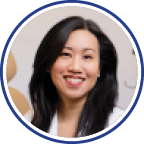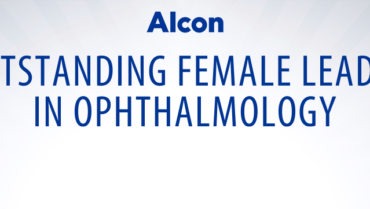
Dr. Sun is the Ophthalmology Residency Program Director and an Assistant Professor in Ophthalmology at New York-Presbyterian Hospital/Weill Cornell Medicine in New York City. She is President-Elect of Women in Ophthalmology (WIO) and started Weill Cornell Ophthalmology’s East Africa Eye Care Program.
1. Please share with us your background.
I like to say that I grew up in the New York Public Library. As the daughter of Chinese immigrants who owned a fish store in Queens, I spent my summers working behind the cash register with my nose in library books. My father, who left his career in education for a chance to come to the United States, taught me about resilience, grit, and hard work. My mother rounded out those lessons with her example of grace, humility, and generosity.
When I set foot on Stanford University’s campus as a college freshman, I felt like I had won the lottery. To this public school kid from New York City, being among the rows of palm trees made me feel like I was walking around a country club—talk about imposter syndrome! Yet, like my immigrant parents, I was drawn far from home by the possibilities of this experience and was excited about the opportunities it offered. While at Stanford, I continued to push myself outside my comfort zone and became brave enough to serve 2 years as a Peace Corps volunteer in Nicaragua after graduation.
Volunteering with the Peace Corps was a formative experience. It solidified my commitment to care for others through a career in medicine and to tackle the health disparities in my community. I came full circle back to New York for medical school at Weill Cornell Medical College and stayed on for residency training at New York Presbyterian Hospital/Weill Cornell. I chose to pursue a career in ophthalmology for the opportunity to restore sight and dramatically change people’s quality of life, both at home and abroad. Locally, I lead Cornell’s community eye care program, which serves the uninsured, many of whom are homeless, indigent, or undocumented. I have continued to work globally by establishing Cornell’s East Africa Eye Care collaboration in Tanzania and serving as a voluntary faculty ophthalmologist with Orbis International.
As a comprehensive ophthalmologist and cataract surgeon, I find great joy in caring for patients. Additionally, my career has been enhanced by my roles in education as a residency program director, in ophthalmic leadership such as within the American Academy of Ophthalmology (AAO), in advocacy as a past president of the New York State Ophthalmological Society (NYSOS), and in the community of Women in Ophthalmology (WIO).
I am a mother to an almost 4-year-old daughter who wants to be an eye doctor or a princess and a wife to a warrior in education reform. As a family, we enjoy taking urban hikes and finding the best pizza in NYC.
2. What is the focus of your recent research?
My research interests are driven by my desire to find solutions to problems that affect areas of ophthalmology about which I am most passionate, including global health and education.
For example, Tanzania is a country of more than 50 million people but has just roughly 50 full-time ophthalmologists. Western Tanzania specifically is home to a growing population of patients with diabetes and hypertension, so a major challenge there is maximizing the use of scarce eye health resources to provide necessary ophthalmic care. Our study helped to determine the prevalence of hypertension and diabetic retinopathy, associated risk factors, and relevant patient knowledge for this population in Tanzania and suggested some parameters to focus their eye care services.
Another area of interest for me is in residency education and surgical training, such as looking at diversity trends in the ophthalmology match and recruitment, the use of simulation in cataract surgical training, and global health education in residency training.
3. What has your experience been collaborating with industry?
Our industry partners are important collaborators in education and training. I currently lead the surgical skills lab of the Association of University Professors in Ophthalmology Surgical Curriculum in Ophthalmology (AUPO SCOR) program. The goal of the SCOR is to provide a standardized system of surgical training and assessment of competency for ophthalmology residents. Another key objective is to allow trainees to learn ophthalmic surgery on multiple surgical platforms (as most programs typically use only one platform) and to access a variety of new devices that may not be available through their program. SCOR seeks to address the lack of accessible educational resources to support surgical competency and decrease variability in skill sets. Our collaborations with industry have been immensely valuable.
I currently lead the surgical skills lab of the Association of University Professors in Ophthalmology Surgical Curriculum in Ophthalmology (AUPO SCOR) program. The goal of the SCOR is to provide a standardized system of surgical training and assessment of competency for ophthalmology residents. Another key objective is to allow trainees to learn ophthalmic surgery on multiple surgical platforms (as most programs typically use only one platform) and to access a variety of new devices that may not be available through their program. SCOR seeks to address the lack of accessible educational resources to support surgical competency and decrease variability in skill sets. Our collaborations with industry have been immensely valuable.
4. In your opinion, how is the role of women in ophthalmology evolving?
Who Says Women Can’t Be Doctors? is one of my daughter’s favorite picture books. It tells the story of Elizabeth Blackwell, MD, the first woman physician in the United States. Because all of my daughter’s doctors are women, as is her “Mommy,” it is puzzling for her to try to imagine a time when women were not allowed to be doctors.
In addition to my daughter’s reaction, several other realities lead me to feel more optimistic about women’s role in ophthalmology. An increasing number of women ophthalmologists are entering practice, and a growing number of women are assuming leadership roles as chairs of academic departments, key opinion leaders in industry, and entrepreneurs. As a member of the WIO board, I have watched the organization’s membership quadruple over the past 5 years and expand to include chapters across the United States and globally. Women continue to organize as seen in subspecialty groups such as the American Glaucoma Society (AGS), American Society of Retina Specialists (ASRS), and North American Neuro-Ophthalmology Society (NANOS), as there is much more work to be done for this community of women in ophthalmology.
5. What hurdles do you feel women in health care still face?
The research on women in medicine has slightly dampened my optimism. We face stubborn challenges that we will continue to overcome in order to achieve parity in pay and equity in representation in leadership, research recognition, and academic promotion. One of my own research projects revealed an alarming finding that women ophthalmology residents performed fewer surgical procedures during training than their male counterparts.
Organizations such as WIO are working on initiatives to target these biases. WIO started a Clinical Trials Program with our industry partners to support women who are interested in leading research. The WIO Speakers Bureau showcases dynamic women speakers on diverse topics in ophthalmology to eliminate manels, or all-male panels. Our Summer Symposium features negotiation workshops and surgical labs for skill acquisition and development. Additionally, AUPO members established Women Professors of Ophthalmology to support the promotion of women in academics to full professors. Additionally, the AUPO Program Directors Council has a working group called Women in Ophthalmology Training, which is dedicated to diving deeper into gender issues in training.
Despite these initiatives, structural barriers, implicit biases, and harassment continue to exist in medicine and may hinder the progress of women in ophthalmology. COVID-19 highlighted some of the unique challenges for women in medicine. Women carry a disproportionate number of hours of child and elder care compared to their male counterparts. One concrete example of how this affects women is that fewer women were lead authors on COVID-19–related papers in 2020—their representation in lead authorship was 23% lower than in 2019. From there, a lower number of research publications, for example, may affect the promotion timeline.
Structural changes at the institution level that can support women in medicine include offering more robust childcare support, enabling more flexible clinical schedules, scheduling fewer department meetings around dinner time, shifting or stopping the tenure clock on promotions, and providing implicit bias training and bystander training. However, to do this, we need more women in leadership to create these changes. As Marian Wright Edelman, Founder and President of the Children’s Defense Fund, said, “You can’t be what you can’t see.”
6. What advice can you offer to young female ophthalmologists who are in training or just beginning their careers?
Build relationships, make connections, and network. I used to think of networking as a bad word, conjuring up images of businessmen standing around and giving sales pitches. In reality, networking is important for women, as many opportunities arise through these social engagements. So, go to an ophthalmology meeting such as the WIO Summer Symposium and network, or join a young ophthalmology community and attend the AAO YO or ASCRS YES events. Connect with mentors and sponsors and build on those relationships for yourself and others. Make it a goal to introduce yourself, ask a question, compliment a speaker on their talk, raise your hand, or connect with others on social media. You’ll find that ophthalmology is an incredibly supportive community.
7. Can you propose a unique or creative idea that may help women in ophthalmic practices?
I recently received a piece of great advice: Every professional obligation on your calendar should be reflected on your CV. It has been shown that women often get tasked with less valued contributions such as serving on committees or writing patient education materials. Get credit, and take credit. We may tend to make excuses for our success and undervalue ourselves when we should be owning and promoting our achievements!
Lastly, speak up and ask for what you want. If you don’t immediately get it, don’t think of it as a failure but as an opportunity. Be specific about your goal—whether it’s a promotion, a higher salary, or more support—and work at it. Then ask again. If you’re successful in this process and your request still isn’t granted, then reflect on whether you are in the right place to advance your career.
PUBLISHED WORKS
- Aguwa UT, Wang J, Woreta F, Pettey J, Sun G, Pineles S, Srikumaran D. Residency program diversity recruitment and education: survey of efforts and barriers to implementation. J Surg Educ. 2021;S1931-7204(21)00339-1.
- Aguwa UT, Srikumaran D, Green LK, Potts JR 3rd, Canner J, Fountain TR, Sun G, Woreta FA. Analysis of sex diversity trends among ophthalmology match applicants, residents, and clinical faculty. JAMA Ophthalmol. 2021;139(11):1184-1190.
- Wendt S, Abdullah Z, Barrett S, Daruwalla C, Go JA, Le B, Li E, Livingston C, Miller M, Nakhleh L, Pecha J, Pothula S, Pradhan S, Sathappan V, Shah A, Sonuyi AM, Ugoh P, Wang Q, Weber N, Succar T, Blieden L, Mortensen P, Elkin Z, Sun G, Lee AG. A virtual COVID-19 ophthalmology rotation. Surv Ophthalmol. 2021;66(2):354-361.
- Woodward R, Rodriguez G, Joseph J, Sun G. Selective laser trabeculoplasty in Western Tanzania. Invest Ophthalmol Vis Sci. 2021;62(8):2557-2557.
- Duong AT, Van Tassel SH, Alzaga Fernandez AG, Amin A, Chadha N, Dagi Glass LR, Dersu I, Goyal A, Graubart EB, Elkin ZP, Kelly L, Kemp PS, Knoch DW, Regina M, Rosenbaum PS, Rosenberg JB, Sankar PS, Sun G. Medical education and path to residency in ophthalmology in the COVID-19 era: perspective from medical student educators. Ophthalmology. 2020;127(11):e95-e98.
- Winebrake J, McMahon J, Sun G. The utility of virtual reality simulation in cataract surgery training: a systematic review. J Academ Ophthalmol. 2020;12:e221-e233.
- Chen RWS, Abazari A, Dhar S, Fredrick DR, Friedman IB, Dagi Glass LR, Khouri AS, Kim ET, Laudi J, Park S, Reddy HS, Rosenberg JB, Sandler SF, Shrivastava A, Sun G, Winokur J. Living with COVID-19: a perspective from New York area ophthalmology residency program directors at the epicenter of the pandemic. Ophthalmology. 2020;127(8):e47-e48.
- Woodward R, Mgaya E, Mwanansao C, Peck RN, Wu A, Sun G. Retinopathy in adults with hypertension and diabetes mellitus in Western Tanzania: a cross-sectional study. Trop Med Int Health. 2020;25(10):1214-1225.
- Gong D, Winn BJ, Beal CJ, Blomquist PH, Chen RW, Culican SM, Dagi Glass LR, Domeracki GF, Goshe JM, Jones JK, Khouri AS, Legault GL, Martin TJ, Mitchell KT, Naseri A, Oetting TA, Olson JH, Pettey JH, Reinoso MA, Reynolds AL, Siatkowski RM, SooHoo JR, Sun G, Syed MF, Tao JP, Taravati P, WuDunn D, Al-Aswad LA. Gender differences in case volume among ophthalmology residents. JAMA Ophthalmol. 2019;137(9):1015-1020.
- Van Tassel SH, Segal KL, Ciralsky JB, Sun G. Response to: Comment on: Eponymous women in ophthalmology: syndromes with prominent eye manifestations named after female physicians. Eye (Lond). 2019;33(5):851-852.
- Van Tassel SH, Segal KL, Ciralsky JB, Sun G. Eponymous women in ophthalmology: syndromes with prominent eye manifestations named after female physicians. Eye (Lond). 2018;32(8):1293-1295.
- Singh R, Dohlman TH, Sun G. Immediately sequential bilateral cataract surgery: advantages and disadvantages. Curr Opin Ophthalmol. 2017;28(1):81-86.
- Christiansen SM, Oetting TA, Herz NL, Law JC, O'Brien CP, Patel PS, Patel R, Pettey JH, Shiba DR, Sun G, Fountain T. Twitter at the 2014 and 2015 annual meetings of the American Academy of Ophthalmology. Ophthalmology. 2016;123(8):1835-1837.
- Siatkowski RM, Mian SI, Culican SM, Green LK, Sun G, Waxman EL, Wayman LL, Stoner J, Chen X, Feldon S; Association of University Professors of Ophthalmology. Probability of success in the ophthalmology residency match: three-year outcomes analysis of San Francisco matching program data. J Acad Ophthalmol. 2018;10(1):e150-e157.
- Coombs PG, Feldman BH, Lauer AK, Paul Chan RV, Sun G. Global health training in ophthalmology residency programs. J Surg Educ. 2015;72(4):e52-e59.
- Chan RV, Patel SN, Ryan MC, et al. The Global Education Network for Retinopathy of Prematurity (Gen-ROP): development, implementation, and evaluation of a novel tele-education system (an American Ophthalmological Society thesis). Trans Am Ophthalmol Soc. 2015;113:T2.
- Wong RK, Khanifar AA, Sun G, et al. Acute retinal necrosis and cystic encephalomalacia in a premature neonate. Retin Cases Brief Rep. 2010;4(2):202-205.
- Chan RV, Yonekawa Y, Morrison MA, et al. Association between assisted reproductive technology and advanced retinopathy of prematurity. Clin Ophthalmol. 2010;4:1385-1390.
- Richter GM, Sun G, Lee TC, et al. Speed of telemedicine vs. ophthalmoscopy for retinopathy of prematurity diagnosis. Am J Ophthalmol. 2009;148(1):136-142.
- Yonekawa Y, Sun G, D’Amico DJ, Chan RV. Retinal necrosis secondary to inadvertent intravitreal methylprednisolone acetate (depo-medrol) injection during pars plana vitrectomy. Retin Cases Brief Rep. 2009;3(4):336-339.
PROFESSIONAL SOCIETY MEMBERSHIPS
- Women in Ophthalmology (WIO) | 2014 to Present
- President-Elect | 2020 to Present
- Board of Directors | 2019 to Present
- Membership Committee | 2018 to 2019
- Summer Symposium, Program Committee | 2016 to 2020
- American Society of Cataract and Refractive Surgery (ASCRS) | 2013 to Present
- ASCRS Foundation International Committee | 2013 to Present
- ASCRS Young Eye Surgeon International Grant Committee | 2019 to Present
- Association of University Professors of Ophthalmology (AUPO) | 2012 to Present
- Program Director Council, President | 2021 to Present
- AUPO Council | 2021 to Present
- Program Director Council, President-Elect | 2020 to 2021
- Program Director Council | 2016 to 2020
- Surgical Curriculum in Ophthalmology Residency (SCOR) Skills Lab Lead | 2019 to Present
- New York State Ophthalmological Society (NYSOS) | 2012 to Present
- President | 2019 to 2021
- Vice-President | 2017 to 2019
- Secretary/Treasurer | 2015 to 2017
- Chair, Young Ophthalmologist Subcommittee | 2013 to 2015
- Board Member | 2012 to Present
- Women in Ophthalmology (WIO), New York | 2010 to Present
- President | 2017 to 2019
- Board of Directors | 2013 to Present
- Chinese American Ophthalmological Society (CAOS) | 2009 to 2017
- Pan American Association of Ophthalmology (PAAO) | 2009 to 2015
- American Academy of Ophthalmology (AAO) | 2006 to Present
- AAO Council State Section Nominating Committee | 2020 to Present
- AAO Councilor | 2017 to Present
- Young Ophthalmologist Committee | 2015 to 2019
- Young Ophthalmologist International Subcommittee Chair | 2015 to 2019
- Global Education and Outreach Committee Member | 2015 to 2019
- Young Ophthalmologist International Subcommittee Member | 2010 to 2014
HONORS & AWARDS
- Secretariat Award, AAO | 2021
- Top Doctors, New York Magazine | 2021
- Top Doctors in New York, Castle Connolly | 2021, 2020
- Humanitarian Award, WIO | 2017
- Secretariat Award, AAO | 2016
- Educators Award, WIO | 2016
- Achievement Award, Asia Pacific Academy of Ophthalmology | 2016
- Achievement Award, AAO | 2015
- Resident Teaching Award, Weill Cornell Medicine, Ophthalmology | 2015
- Leadership Development Program, AAO | 2015
- New York Super Doctors Rising Stars, New York Super Doctors | 2014, 2015
- Leadership Development Program, NYSOS | 2012
- Paul Kayser International Scholar, PAAO | 2010
- National Eye Institute Travel Grant, Association for Research in Vision and Ophthalmology | 2008
- Edward Norton Prize in Ophthalmology, Weill Medical College of Cornell University | 2005
- Honors in Human Biology, Stanford University | 1997


